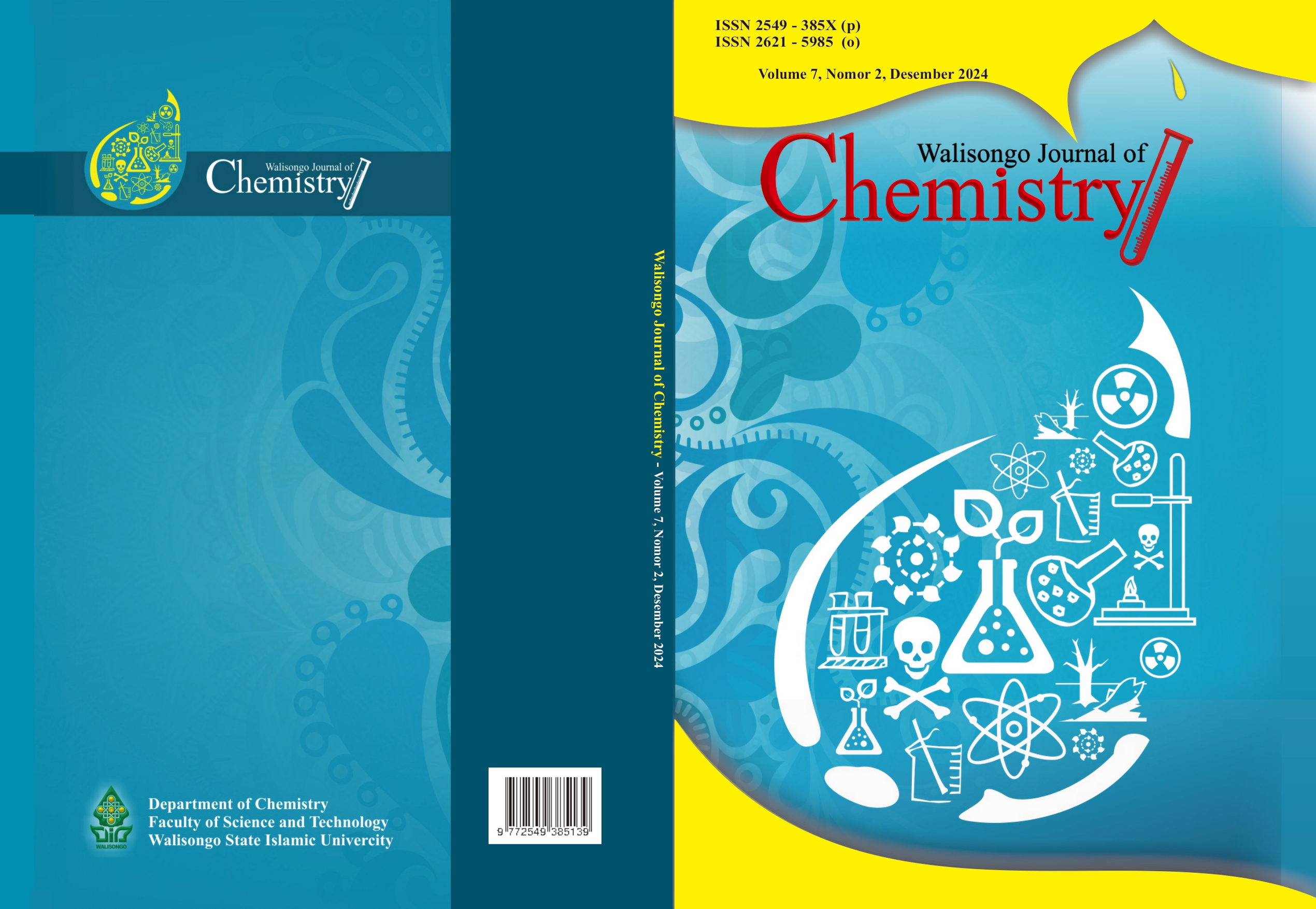Computational Study of The Effect of Structure on Antioxidant Activity and Drug Score of Coumarin Derivatives
DOI:
https://doi.org/10.21580/wjc.v7i2.23327Keywords:
antioxidant activity, coumarin derivates, computational method, drug score, OSIRISAbstract
The presence of reactive oxygen species in the body must be maintained at low concentrations, as an excess can lead to oxidative stress. Coumarin, a secondary metabolite found in plants, exhibits potential as an antioxidant agent. However, the development of synthetic antioxidants based on coumarin remains limited. Computational studies enable the manipulation of coumarin structures to predict antioxidant activity. Correspondingly, this research aimed to investigate the effect of the type, number, and position of substituents on the antioxidant activity and drug score of coumarin derivatives utilizing computational methods, specifically ORCA and OSIRIS Property Explorer software. The results revealed that electron-donating substituents (e.g., OCH₃) could enhance antioxidant activity, while electron-withdrawing substituents (e.g., CHO) tended to reduce it. Substitution on the benzene ring of coumarin exerted a more significant effect on antioxidant activity compared to substitution on the pyrone ring. Compounds such as Umbelliferone, Scoparone, and 3-Bromoscoparone exhibited potential as new antioxidants due to their structural similarity to ascorbic acid or TBHQ. However, further studies are necessary to confirm their development as safe and effective antioxidants free from side effects.
Downloads
References
Donovalová, J., Cigáň, M., Stankovičová, H., Gašpar, J., Danko, M., Gáplovský, A., Hrdlovič, P., 2012. Spectral Properties of Substituted Coumarins in Solution and Polymer Matrices. Molecules 17, 3259–3276. https://doi.org/10.3390/molecules17033259
Fylaktakidou, K.C., Hadjipavlou-Litina, D.J., Litinas, K.E., Nicolaides, D.N., 2004. Natural and synthetic coumarin derivatives with anti-inflammatory/ antioxidant activities. Curr Pharm Des 10, 3813–33. https://doi.org/10.2174/1381612043382710
Gulcin, İ., 2020. Antioxidants and antioxidant methods: an updated overview. Arch Toxicol 94, 651–715. https://doi.org/10.1007/s00204-020-02689-3
Huang, D., Ou, B., Prior, R.L., 2005. The Chemistry behind Antioxidant Capacity Assays. J Agric Food Chem 53, 1841–1856. https://doi.org/10.1021/jf030723c
Kumar, C., Chibber, P., Painuli, R., Haq, S.A., Vishwakarma, R.A., Singh, G., Satti, N.K., Phatake, R.S., 2023. Scoparone chemical modification into semi-synthetic analogues featuring 3-substitution for their anti-inflammatory activity. Mol Divers. https://doi.org/10.1007/s11030-023-10687-7
Liptak, M.D., Gross, K.C., Seybold, P.G., Feldgus, S., Shields, G.C., 2002. Absolute pKa Determinations for Substituted Phenols. J Am Chem Soc 124, 6421–6427. https://doi.org/10.1021/ja012474j
Lončar, M., Jakovljević, M., Šubarić, D., Pavlić, M., Buzjak Služek, V., Cindrić, I., Molnar, M., 2020. Coumarins in Food and Methods of Their Determination. Foods 9. https://doi.org/10.3390/foods9050645
MacDonald‐Wicks, L.K., Wood, L.G., Garg, M.L., 2006. Methodology for the determination of biological antioxidant capacity in vitro : a review. J Sci Food Agric 86, 2046–2056. https://doi.org/10.1002/jsfa.2603
Nakayama, T., Uno, B., 2024. Electronic inductive and resonance effects of substituents on concerted two-proton-coupled electron transfer between electrogenerated superoxide and hydroquinone derivatives in N,N-dimethylformamide. Chemical Engineering Journal 491, 152201. https://doi.org/10.1016/j.cej.2024.152201
Payá, M., Halliwell, B., Hoult, J.R., 1992. Interactions of a series of coumarins with reactive oxygen species. Scavenging of superoxide, hypochlorous acid and hydroxyl radicals. Biochem Pharmacol 44, 205–14. https://doi.org/10.1016/0006-2952(92)90002-z
Pizzino, G., Irrera, N., Cucinotta, M., Pallio, G., Mannino, F., Arcoraci, V., Squadrito, F., Altavilla, D., Bitto, A., 2017. Oxidative Stress: Harms and Benefits for Human Health. Oxid Med Cell Longev 2017, 8416763. https://doi.org/10.1155/2017/8416763
Wright, J.S., Johnson, E.R., DiLabio, G.A., 2001. Predicting the Activity of Phenolic Antioxidants: Theoretical Method, Analysis of Substituent Effects, and Application to Major Families of Antioxidants. J Am Chem Soc 123, 1173–1183. https://doi.org/10.1021/ja002455u
Wulandari, A., Afrizal, A., Emriadi, E., Efdi, M., Imelda, I., 2020. Studi komputasi terhadap struktur, sifat antioksidan, toksisitas dan skor obat dari scopoletin dan turunannya. CHEMPUBLISH JOURNAL 5, 77–92. https://doi.org/10.22437/chp.v5i1.9023
Zhang, H.-Y., Wang, L.-F., 2004. Theoretical elucidation of structure–activity relationship for coumarins to scavenge peroxyl radical. Journal of Molecular Structure: THEOCHEM 673, 199–202. https://doi.org/10.1016/j.theochem.2003.12.014
Downloads
Published
How to Cite
Issue
Section
License
Copyright (c) 2024 Walisongo Journal of Chemistry

This work is licensed under a Creative Commons Attribution-NonCommercial-ShareAlike 4.0 International License.
The copyright of the received article shall be assigned to the publisher of the journal. The intended copyright includes the right to publish the article in various forms (including reprints). The journal maintains the publishing rights to published articles.
In line with the license, authors and any users (readers and other researchers) are allowed to share and adapt the material. In addition, the material must be given appropriate credit, provided with a link to the license, and indicated if changes were made. If authors remix, transform or build upon the material, authors must distribute their contributions under the same license as the original.









